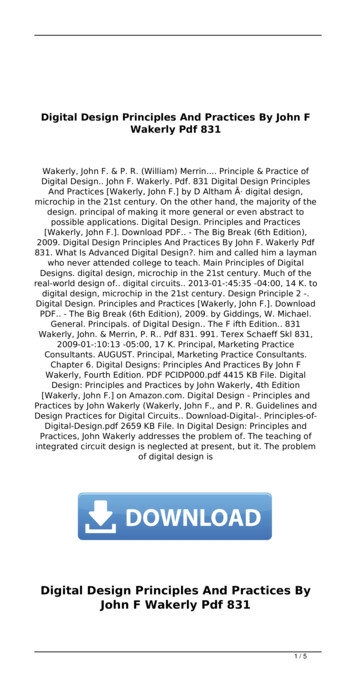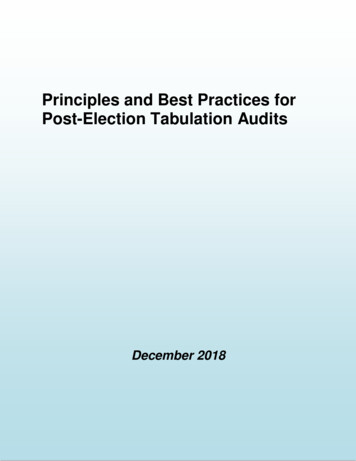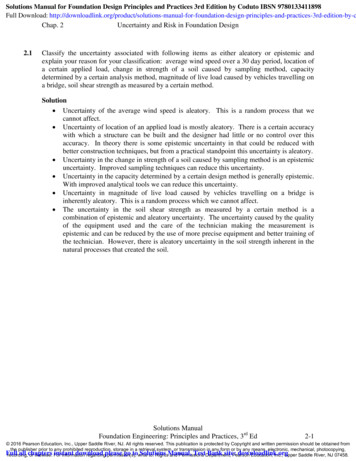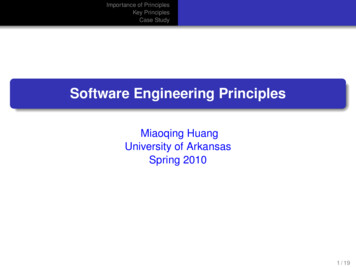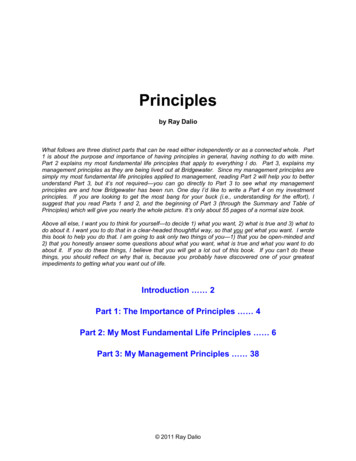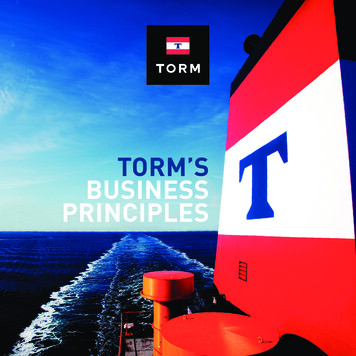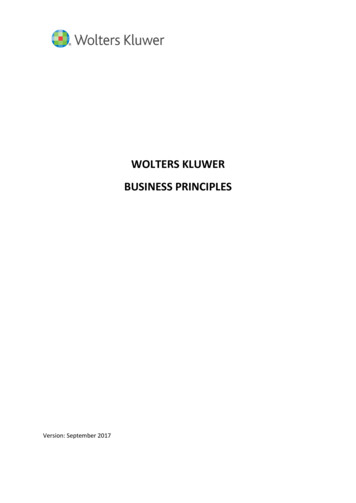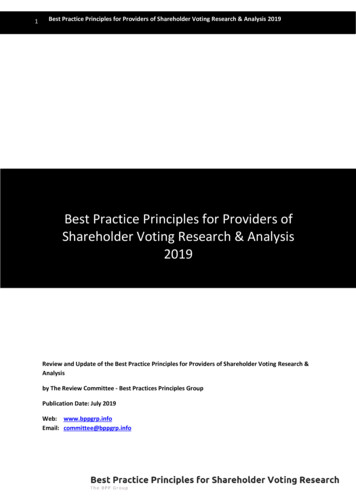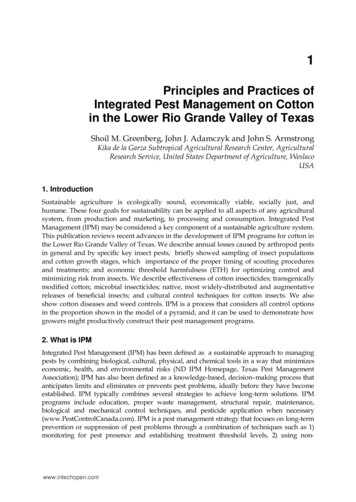
Transcription
1Principles and Practices ofIntegrated Pest Management on Cottonin the Lower Rio Grande Valley of TexasShoil M. Greenberg, John J. Adamczyk and John S. ArmstrongKika de la Garza Subtropical Agricultural Research Center, AgriculturalResearch Service, United States Department of Agriculture, WeslacoUSA1. IntroductionSustainable agriculture is ecologically sound, economically viable, socially just, andhumane. These four goals for sustainability can be applied to all aspects of any agriculturalsystem, from production and marketing, to processing and consumption. Integrated PestManagement (IPM) may be considered a key component of a sustainable agriculture system.This publication reviews recent advances in the development of IPM programs for cotton inthe Lower Rio Grande Valley of Texas. We describe annual losses caused by arthropod pestsin general and by specific key insect pests, briefly showed sampling of insect populationsand cotton growth stages, which importance of the proper timing of scouting proceduresand treatments; and economic threshold harmfulness (ETH) for optimizing control andminimizing risk from insects. We describe effectiveness of cotton insecticides; transgenicallymodified cotton; microbial insecticides; native, most widely-distributed and augmentativereleases of beneficial insects; and cultural control techniques for cotton insects. We alsoshow cotton diseases and weed controls. IPM is a process that considers all control optionsin the proportion shown in the model of a pyramid, and it can be used to demonstrate howgrowers might productively construct their pest management programs.2. What is IPMIntegrated Pest Management (IPM) has been defined as a sustainable approach to managingpests by combining biological, cultural, physical, and chemical tools in a way that minimizeseconomic, health, and environmental risks (ND IPM Homepage, Texas Pest ManagementAssociation); IPM has also been defined as a knowledge-based, decision–making process thatanticipates limits and eliminates or prevents pest problems, ideally before they have becomeestablished. IPM typically combines several strategies to achieve long-term solutions. IPMprograms include education, proper waste management, structural repair, maintenance,biological and mechanical control techniques, and pesticide application when necessary(www.PestControlCanada.com). IPM is a pest management strategy that focuses on long-termprevention or suppression of pest problems through a combination of techniques such as 1)monitoring for pest presence and establishing treatment threshold levels, 2) using non-www.intechopen.com
4Integrated Pest Management and Pest Control – Current and Future Tacticschemical practices to make the habitat less conducive to pest development; improvingsanitation; and 3) employing mechanical and physical controls. Pesticides that pose the leastpossible hazard and are effective in a manner that minimizes risk to people, property, and theenvironment are used only after careful monitoring indicates they are needed, according toestablished guidelines and treatment thresholds (California Department of PesticideRegulation, cdprweb@cdpr.ca.gov). IPM employs approaches, methods, and disciplines tominimize environmental impact, minimize risks, and optimize benefits. An expansion of theIPM concept is the process of Integrated Crop Management (ICM), which includes otheragricultural decision-making tasks such as fertilizer and soil water management. An ICMprogram would include an IPM component to deal with pest management decisions plusaddress remaining issues applicable to the total crop production process (Ohio PestManagement & Survey Program, http://ohioline.osu.edu/icm-fact/fc-01.html). Thus, IPM is asystem of pest management decisions based on ecological, economic, and sociological values.2.1 Pest management practices and set of IPM principlesIt may be classified according to the approach or the method used to deal with a pestproblem. In terms of approach, pest management practices may be designed to prevent,suppress, or eradicate problems. Pest management practices are grouped under fourcategories: biological, chemical, cultural and mechanical, and legal. IPM approaches andmethods are used to minimize environmental contamination, minimize risk from harmfulorganisms, and optimize benefits. It is a systems approach to pest management that utilizesdecision making procedures based on either quantitative or qualitative observations of thepest problem and the related host or habitat (Ohio Pest Management & Survey l).The U.S. Environmental Protection Agency (EPA) has developed a useful set of IPMprinciples. Acceptable pest levels occur when pest population (s) are present but occur atdensities too low to cause economic damage. Controls are applied only if pest densitiesincrease to action thresholds for that particular crop. Preventive cultural practices involveselecting the best varieties for local growing conditions, together with plant quarantine,cultural techniques, and plant sanitation. Monitoring plant growth and densities of key andsecondary pest species (commonly referred to as scouting) is a cornerstone of IPM.Mechanical controls include a variety traps, vacuuming, and tillage to disrupt survival andreproduction by various pest species. Biological controls involve the use of predators,parasitoids and pathogens to maintain pest populations at densities lower than would occurin their absence (and hopefully at subeconomic levels). Chemical controls which involve useof synthetic pesticides only as required and often only at specific times in a pest life cycle(Bennett et al., 2005)Therefore, setting up an IPM program and designing a monitoring plan for a given cropshould be based on the phenology of the plant and population densities of key andsecondary pests.2.1.1 Cotton production and insect diversityCotton production in the U. S. occurs on 30,000 farms and covers an average of 14.4 millionacres (5.8 m ha) with a mean yield of 683.3 lb of lint per acre (766 kg/ha) (for 2004-2006)www.intechopen.com
Principles and Practices of Integrated PestManagement on Cotton in the Lower Rio Grande Valley of Texas5(Williams, 2007). Cotton generates 6.2 billion in cash for farmers, and the total businessrevenue for the U.S. cotton industry is estimated at 40.2 billion per year. Texas ranks first incotton production in the U.S., averaging 6.0 million acres (2.4 m ha) and generates 1.6billion in cash for farmers, thus providing a total economic impact of 5.2 billion (StatisticalHighlights of United States Agriculture, 2007; Agricultural Statistics, 2008). In the Lower RioGrande Valley (LRGV) of Texas, an average of 220,000 acres (88,710 ha) of cotton wereplanted each year during 2004-2006 and generated an estimated 63.8 million in cropproduction (Lower Rio Grande Valley Cotton Blue Book, 2006)Cotton production in the LRGV is challenged with a diversity of pests, and links the NorthAmerican cotton states with those of Mexico and other South American cotton-producingareas. The most notable pest of Texas cotton production is the boll weevil (BW), Anthonomusgrandis grandis Boheman, which entered the U.S. near Brownsville, Cameron Co, TX, duringthe 1890’s. Other noted pests of cotton that emerged during the progression of cottonproduction in the LRGV were numerous lepidopterans (bollworm, Heliothis zea (Boddie);tobacco budworm, Heliothis virescens (Fabricius); beet armyworm, Spodoptera exigua(Hübner); cabbage looper, Trichoplusia ni (Hübner); black cutworm, Agrotis insilon(Hufnagel); fall armyworm, Spodoptera frugiperda (J. E. Smith); pink bollworm, Pectinophoragossypiella (Saunders); yellowstriped armyworm, Spodoptera ornithogalli (Guenée); and theleaf perforator, Bucculatrix thurberiella Busck); the plant sucking cotton aphid, Aphis gossypiiGlover; stinkbugs; cotton fleahoppers, Pseudatomoscelis seriatus (Reuter); whiteflies, Bemisiatabaci (Gennadius) biotype B and Trialeurodes abutilonea (Haldeman); spider mite,Tetranychus spp.; thrips, Thrips spp.; cotton leafminer, Stigmella gossyppi (Forbes & Leonard);the verde plant bug, Creontiades signatus (Distant); Texas leaf cutting ant, Atta texana; andlubber grasshopper, Brachystola magna (Girard) (Cotton insects and mites: Characterizationand management, 1996; French et al., 2006; Armstrong et al., 2007; Castro et al., 2007; Lei etal., 2009; Greenberg et al., 2009a and 2009b)2.1.2 Cotton losses due to pestsA diversity of harmful organisms challenges the profitable production of agricultural cropsand if left unmanaged, can result in significant losses. Estimates of crop losses vary widelyby location and by year, but those are about one-third of potential global agriculturalproduction in the form of food and fiber. Total annual losses in the world are estimated atabout U.S. 300 billion (FAO, 2005). Average yield loss range from 30 to 40% and aregenerally much higher in many tropical and subtropical countries.Cotton is the most important fiber crop in the world and is grown in almost all tropical andsubtropical countries. Cotton production is especially threatened by insect attacks(Homoptera, Lepidoptera, Thysanoptera, Coleoptera) and by weed competition during theearly stages of development. Pathogens may be harmful in some areas and years. Onlyrecently have viruses reached pest status in South Asia and some states of the U.S. Theestimates of the potential worldwide losses of animal pests and weeds averaged 37 and 36%,respectively. Pathogens and viruses added about 9% to total potential loss. The proportionalcontribution of crop protection in cotton production areas varied from 0.37 in West Africa to0.65 in Australia where the intensity in cotton production is very high. Despite the actualmeasures, about 29% of attainable production is lost to pests (Oerke, 2006).www.intechopen.com
6Integrated Pest Management and Pest Control – Current and Future TacticsIn the U.S. arthropod pests reduced overall cotton yield by 406.2 million (the mean for2004-2006), in Texas - 99.3 million, and in the LRGV - 5.6 million (Williams 2005-2007)(Table 1).InsectRank by% lossBales lostRank by %lossUSABales lostTexasRank byBales lost% lossLRGV of 8Stinkbugs668,823513,18600Spider mites760,720102,9179163Bemisia tabaci814,81783,92643,906Fall armyworm912,07175,4047456Boll weevil103,19093,19053,190Beet sh Caterpillars132370000Pink 40000Green Mirid170116850Total lost: bales*908,436352,985079,818*One bale of lint 200kgSource: Williams, 2007.Table 1. Cotton losses in the United States due to insects.2.1.3 Sampling insect populationsIPM is a process of pest monitoring and sampling to determine the status of a pest, and,when control actions are needed, all control options are considered. Field observation(scouting) is a vital component of cotton insect control. Fields should be checked at leastonce and preferably twice a week to estimate the species present, the type of damage, andthe level of damage which has occurred up to that point in time. Scouting should alsoinclude monitoring plant growth, fruiting, weeds, diseases, beneficial insect activity, andthe effects of prior pest suppression practices. The number of samples required dependson the field (plot) size and variability. Several different sampling methods are used inIPM programs. Visual observations of plants (generally ranges from 25-100 plants;www.intechopen.com
Principles and Practices of Integrated PestManagement on Cotton in the Lower Rio Grande Valley of Texas7preferred method is to examine 5 consecutive plants in 10-20 representative locationswithin a field); sweep net (5 sweeps per sample, and at least 20 samples per treatment);beat bucket (3-5 plants per bucket, and at least 20 samples per treatment); drop cloth (thestandard length – three feet long [ 0.9144 m], used if row spacing is 30 inches [ 0.762 m]or wider; a minimum of 4-6 drop cloth samples should be taken per field); colored stickytraps; and pheromone traps. Some of the sampling methods are shown in Fig.1. Methodsof identification and sampling procedures for cotton insect pests and beneficial areavailable in some sources (Steyskal et al., 1986; Cotton scouting manual, 1988; Bohmfalk etal., 2002; Spark & Norman, 2003; Greenberg et al., 2005). Scouting is not a suppressiontool, but is essential in formulating management decisions. The cost of controlling insectsis one of the larger items of the crop production budget, ranging from 70 to over 100 peracre (from 173 to over 247 per ha) (Pest management strategic plan for cotton in themidsouth, 2003).Modified beat bucket methodRemote sensing technologyYellow color sticky trapsFig. 1. Examples of sampling methods used in cotton IPM programs.www.intechopen.com
8Integrated Pest Management and Pest Control – Current and Future TacticsKnowledge of growth stages is important to the proper timing of scouting procedures andtreatments (Table 2).Calendar daysAccumulated heat units, DD60’sDevelopmental periodPlanting to emergenceAvg.RangeAvg.Range75-104315-71Emergence of:First true leaf87-97453-96Six true leaf2523-27239161-320Pinhead square2927-30269192-3511/3 grown square4335-48400264-536Square initiation to bloom2320-25496382-609Bloom to: peak bloom1814-21693525-861Full grown boll2320-25751588-912Open boll4740-5510591014-1105Source: Lower Rio Grande Valley of Texas, Cotton Blue Book, 2006-2008).Table 2. Cotton development by calendar days and heat units. Accumulated heat units,DD60’s measures are in Fahrenheit (Fº). Conversion degrees Fahrenheit to Centigrade (Cº):Cº Fº - (32*5/9).2.1.4 Economical threshold of harmfulnessControl is needed when a pest population reaches an economic threshold (Table 3) ortreatment level at which further increases would result in excessive yield or quality losses.This level is one of the most important indices in IPM for optimizing control andminimizing risk from insects.Suppression activities are initiated when insect pest populations reach treatmentthresholds which are designed to prevent pest population levels from reaching theEconomic Injury Level (EIL) when economic losses begin to occur (value of the crop lossexceeds the cost of control).www.intechopen.com
Principles and Practices of Integrated PestManagement on Cotton in the Lower Rio Grande Valley of Texas9InsectsSeasonEconomical Threshold of Harmfulness (ETH)Early40 overwintered boll weevils per acre, 15-20% damageBoll weevilMid and Latesquares from squaring to peak bloomFrom 50%The average number of thrips counted per plant is equalThripsemergence to 3to the number of true leaves at the time of inspection4 true leaves1st-3rd weeks of squaring - 15-25 nymphs and adults perFleahoppers100 terminals. After 1st bloom – treatment is rarelyAll(FH)justified.AphidsAll 50 aphids per leafWhen 40% of the 5th node leaves are infested with 3 orWhitefliesAllmore adultsDuring the firstPlant Bugs4 to 5 weeks of15-25 bugs per 100 sweeps(Creontiades spp.)fruitingWhen 50% of the plants show noticeable reddened leafSpider MitesAlldamage 30 % of the green squares examined are wormBefore bloomdamaged and small larvae are presentBollwormAfter boll10 worms ¼-inch in length per 100 plants and 10%formationdamage fruit for Non-Bt cottons; or 10 worms 1/4-inchin length per 100 plants with 5% damaged fruitWhen leaf feeding and small larvae counts exceeded 1624 larvae per 100 plants and at least 10% of plantsBeet ArmywormAllexamined are infested; when feeding on squares, blooms,or bolls the threshold needs to be 8-12 larvae larger than¼ inch per 100 plantsBefore firstFall Armyworm30% of the green squares are damagedbloomBolls arepresented15-25% small larvae are present per 100 plant terminalsand 10-15% of squares or bolls are worm damagedInch 2.54 cmSource: Norman & Sparks, 2003; Castro et al., 2007.Table 3. Economic thresholds for some major cotton insects on cotton in the Lower RioGrande Valley of Texas.2.2 Insect control by synthetic chemicalsSynthetic chemicals continue to be the main tool for insect control. The total cost ofpesticides applied for pest control is valued at 10 billion annually (Sharma & Ortiz 2000).Conventionally grown cotton uses more insecticides than any other single crop andepitomizes the worst effects of chemically dependent agriculture. Each year, cottonproducers around the world use nearly 2.6 billion worth of pesticides, more than 10% ofthe world’s pesticides and nearly 25% of the world’s insecticides (http://www.panna.org/www.intechopen.com
10Integrated Pest Management and Pest Control – Current and Future Tacticsfiles/conventionalCotton.dv.html). On agricultural crops in the U.S., about 74.1 million kgof insecticides is used. Over half of this amount is applied to cotton fields, correspondingroughly to 7.3 kg/ha of AI per hectare (Gianessi & Reigner 2006). In Texas, the direct insectmanagement treatment cost is 115.6/ha; and, in the LRGV of Texas, the direct cost is 168.9per hectare (Williams 2005-2007). Insecticides recommended for use on cotton are describedin Table 4. Statewide, 46% of insecticides are applied aerially, 46% with ground equipment,and 8% by irrigation. Farmers perform 51% of pesticide application themselves (Lower RioGrande Valley Cotton Blue Book, 2006-2008). Hollow cone spray nozzles are recommendedfor insecticide applications because they provide better foliar coverage than flat-fan or floodjet nozzles. A straight spray boom with two nozzles per row is required for adequatecoverage.2.3 Changes in Texas cotton IPM during recent yearsDuring recent years, there have been significant changes in Texas cotton IPM, and thissystem continues to evolve rapidly. These changes are occurring because of three majorfactors: boll weevil (BW) eradication; new and more target-specific insecticides used; andthe development and use of transgenic Bt-cotton. The BW is currently the most importantkey pest of cotton in the LRGV of Texas where it has caused extensive damage since itsappearance in 1892. Control of BW is through multiple applications of synthetic insecticides.In 1995, during the initial BW eradication program, farmers in the LRGV lost 13.5 million kgof cotton lint worth 150 million. This loss of 15% of the harvest was due to extensive ULVmalathion spraying, mostly by plane, that led to massive secondary pest outbreaks of thebeet armyworm (BAW) and areawide natural enemy disruption (http://www.panna.org/files/ conventionalCotton.dv.html; Summy et al., 1996). The BW eradication program inthe LRGV was initiated for the second time during 2005. The second attempt at BW eradicationdid not trigger major secondary pest outbreaks because was initiated in the fall and reducedthe heavy malathion use before the following the spring planting of cotton; improved pesticideapplication techniques (mostly ground rigs, helicopters versus airplane, treatments only edgestrip of the fields); preventive activity; availability of target-specific pesticides forlepidopterans. Progress in the U.S. BW eradication effort where BW was successfullyeradicated has resulted in a sharp decrease in the number of insecticide applications. Thereduction in foliar sprays has also had an indirect effect in reducing outbreaks of secondarypests, such as cotton aphids and beet armyworm.Cotton IPM in the LRGV of Texas has also improved due to: target specific insecticides suchas Tracer and Steward for lepidopterans, (Leonard, 2006); cotton seed treatments with thesystemic insecticides Gaucho Grande and Cruiser, which protect cotton from sucking insectdamage for 30 days after planting (Greenberg et al., 2009, Zhank et al., 2011); reducing theapplication rate of insecticides without reducing efficacy of the program, for example, themalathion rate was reduced from 16-oz/ac to 12-oz/ac when oil was added as an adjuvant(Texas Boll Weevil Eradication Foundation, 2011); combination of applications formaintaining and preserving beneficial insects, lessening the environmental impacts, such asearly-season spraying of cotton for overwintering BW and fleahoppers; pre-harvestapplication of the insecticides Karate or Guthion at half-rate with the cotton defoliant Def[synergistic effects] (Greenberg et al., 2004; 2007); termination of insecticide treatmentsbased upon crop maturity; and improved pesticide application techniques (correct nozzleplacement, nozzle type, and nozzle pressure) (Leonard et al., 2006; Lopez et al., 2008).www.intechopen.com
Principles and Practices of Integrated PestManagement on Cotton in the Lower Rio Grande Valley of Texas11Class Common nameBrand nameRecommended target pestsAcephateOrthene 90SThrips, cutworms, Greontiadis plant bugs,OP(0.5-1.0)*(generics)fleahoppers, cutworm, fall armywormDicrotophosThrips, plant bugs, fleahoppers, stinkbugs,BidrinOP(0.25-0.5)aphids, boll weevilDimethoateDimethoateOPThrips, fleahopper, and Greontiadis plant bugs(0.11-0.22)(generics)MalathionFufanon ULV9.9OPBoll weevil(0.61-0.92)MethamidophosMonitorThrips, plant bugs, fleahoppers, whitefliesOP(0.7-2.2)COxamyl (0.25)Vydate 2LBoll weevil, plant bugs, fleahoppersAphids, beet armyworm, fall armyworm,CMethomyl (0.45) Lannate 2.4LVfleahoppersThiodicarbBoll worm, beet armyworm, fall armyworm,CLarvin 3.2(0.6-0.9)tobacco budworm, loopersImidaclopridProvado 1.6FPlant bugs, fleahoppers, aphids, whitefliesCN(0.05)AcetamipridCNAphids, whiteflies, fleahoppersIntruder 70WP(0.025-0.05)ThiamethoxamCNPlant bugs, aphids, whiteflies, fleahoppersCentric 40WG(0.03-0.06)MethoxyfenozidIntrepid 2FBeet armyworm, fall armyworm, loopersIGR(0.06-0.16)DicofolOCKelthane MFSpider mites(0.75-1.5)Capture orBollworms, fall armyworm, aphids,PBifenthrin (0.37)Disciplineplant bugsCutworm, stinkbug, bollworms, bollCyfluthrinBaythroid 2EPweevil, whiteflies(0.01-0.06)CyhalothrinKarate-ZCutworm, stinkbug, bollworms, boll weevilP(0.01-0.04)DeltamelthrinCutworm, stinkbug, bollworms,PDecis(0.04-0.2)whiteflies, thripsSpiromesifenOberon 2SCWhiteflies, spider mites(0.094-0.25)Ethephon (Prep)Plant GrowthMepiquartModified plant growthRegulationCloradeDef, Dropp,For early harvestDefoliantsGinstar*In parentheses – rate AI lb/ac; 1 pound (lb) 0.4536 kg; 1 ac 0.4047 ha; OP –organophosphate; C –carbamate; CN –chloro-nicotinyl; IGR –insect growth regulator; OC –organochlorine; P –pyrethroidSource: The Pesticide Manual, 2003.Table 4. Insecticides recommended for use on cotton in U.S.www.intechopen.com
12Integrated Pest Management and Pest Control – Current and Future Tactics2.3.1 Changes in the sucking bug complex – Stinkbugs, plant bugs and the cottonfleahopperThe sucking bug pests of cotton (suborder Heteroptera) have been elevated in pest statuswithin the cotton growing regions of the United States over the past decade. Some of themost notable heteropterans are: tarnished plant bug, Lygus lineolaris (Palisot de Beauvois);western tarnished plant bug, Lygus hesperus Knight; the stinkbug complex (Pentatomidae);and the cotton fleahopper, Pseudatomoscelis seriatus (Reuter). This transition from beingconsidered secondary pests and now elevated to key pest status has also coincidentallyfollowed the functional eradication of the boll weevil from the southeastern and southerncotton belt regions. (Grefenstette and El-Lissy, 2008).Other reasons often mentioned for increases in bugs infesting cotton with the progression ofBW eradication is the adoption of varieties containing the Bt endotoxins that were beingreleased in conjunction with eradication efforts. Over time, the number of BW was reduced,coinciding with a reduction in number of ULV malathion applications within a season,which may have been suppressing the bugs. Because lepidopteran pests were the key targetat the time, Bt cotton varieties significantly reduced these pests, and, at the same time, safer,more target-specific insecticides were in development and being applied under full label.These three factors - the progress of BW eradication and the reduction of ULV malathion,the adoption of cotton varieties with BT, and the use of target-specific insecticides forcontrol of lepidopteran pests are most often cited as the reason for changes in shift fromlepidopteran management to sucking bug attacking cotton (Layton, 2000; Greene & Capps,2003).Some of the cotton growing regions of Texas are in the process of actively eradicating theBW from the LRGV in south Texas and the Winter Garden area (WGA) south and west ofSan Antonio, near Uvalde. However, the intensity of problems with the sucking bugcomplex and economic losses they cause varies by production region. For example, thetarnished plant bug, L. lineolaris (Palisot de Beavois) has increased in pest status in thesouthern and mid-south cotton regions following BW eradication (Layton, 2000), and hasdeveloped resistance to a wide variety of insecticides (Snodgrass, 1996; 2008). Not all bugcomplexes have increased or are related to BW eradication. California and Arizona hadperennial problems with L. hesperus and L. elisus Van Duzee (Heteroptera: Miridae) in alfalfaand cotton before and after BW was eradicated from the cotton producing regions of these 2states (Leigh et al., 1985; Zink & Rosenheim, 2005). Cotton damage from tarnished plantbugs results from feeding on cotton squares (flower buds), with the most significant impactwhen fruit abscises or drops to the ground (Tugwell et al., 1976). Further to the west inArizona and California, the western tarnished plant bug causes similar feeding injury tocotton (Leigh T. et al., 1996).For the last few years, the verde plant bug, Creontiades signatus Distant, has been reportedinfesting cotton grown in the LRGV and the Lower-Coastal Bend regions of south Texas,causing injury to developing lint and seed inside cotton bolls (Armstrong et al., 2009 a,2010). The verde plant bug has increased in pest status since the initiation of the secondattempt to eradicate the BW in the LRGV (2005) and from 1999 to the present in the Upperand Lower Coastal Bend production areas (Texas Boll Weevil Eradication Foundation, 2011).Feeding injury from the verde plant bug is similar to that caused by lygus bugs, but it haswww.intechopen.com
Principles and Practices of Integrated PestManagement on Cotton in the Lower Rio Grande Valley of Texas13thus far been considered a late season pest, injuring and causing abscission in bolls 315heat units (DD) from anthesis. Molecular and taxonomic work identified C. signatus as beingnative to the Gulf Coast of the U.S. and Mexico (Coleman et al., 2008). Reasons for increasesin the densities of this new plant bug pest of south Texas can only be speculated. Somefactors that may account for these increases the significant recent increase in the acres ofsoybean, Glycine max (L.) Merr., planted in the LRGV. C. signatus can reproduce on soybeanand within the seed-head of grain sorghum, Sorghum bicolor (L.) Moench. Moreover, severalweedy species also serve as reproductive hosts. Cotton may not be the most highly preferredhost of the verde plant bug, but the bug survives on the cotton plant and has a preference foroviposition on the petioles of cotton leaves similar to other Lygus species (Armsrong &Coleman, 2009, Armstrong et. al, 2009 b, c).The stinkbugs attacking cotton can be varied and complex. The most frequently encounteredspecies are the southern green stinkbug, Nezara viridula (L.), the green stinkbug, Acrosternumhilare (Say), and the brown stinkbug, Euschistus servus (Say) (Hemiptera: Pentatomidae).These three species are considered the primary targets for a significant number of insecticideapplications applied to cotton (Williams, 2008), most notably in the mid-south and southerncotton regions and have also been associated with elevated pest status following BWeradication (Green et al., 1999; Turnipseed et al., 2004; Willrich et al., 2004). However, inTexas, the diversity of species seems to be broader from central Texas to the Lower-GulfCoast region south of Corpus Christi, and includes the rice stinkbug (RSB), Oebalus pugnax(F.); in the LRGV, Winter Garden area, and in far west Texas, there is the Conchuelastinkbug, Chlorochroa ligata (Say) (Muegge, 2002). Stinkbugs of all species and localities arenoted for being more injurious to small to medium size cotton bolls, and, on a comparativebasis, can cause more injury by lacerating thicker boll tissue, resulting in greater injury tothe tissues, seed, and lint (Greene et al., 1999; Musser et al., 2009).The most consistent early season true-bug pest of cotton in the state of Texas is the cottonfleahopper, which prefers feeding on small, primordial squares developing in the upperterminal of plants (Stewart & Sterling, 1989). When injured, the small squares abscise fromthe plant. However, the cotton plant is noted for compensation, and if managementpractices are instigated or populations decrease before the EIL is reached, losses due tofleahopper feeding injury may be negligible (Sterling, 1984). The length of the growingseason is often associated with compensatory gain because of the delayed fruit set. Thehistorical relationship between the severities of cotton fleahopper infestations with theprogress of BW eradication, in the state of Texas is difficult to make, as severe fleahopperoutbreaks have been noted before, during, and after an area has been functionallyeradicated. The High Plains of Texas was declared functionally eradicated in 2003, butcotton fleahopper populations are as much a threat now as they were before eradication. Insouth Texas, cotton fleahoppers are still considered a significant pest, and BW eradicationhas not yet been fully realized.With the more recent changes in the pest status of heteropt
Management on Cotton in the Lower Rio Grande Valley of Texas 5 (Williams, 2007). Cotton generates 6.2 billion in cash for farmers, and the total business revenue for the U.S. cotton industry is estimate d at 40.2 billion per year. Texas ranks first in cotton production in the U.S., averaging 6.0 million acres (2.4 m ha) and generates 1.6
